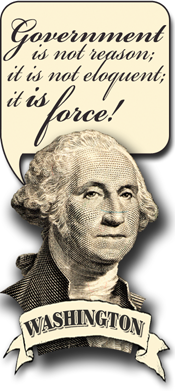Filed under: Capitalism, Domestic Policy, Economy, Liberalism, Statism | Tags: Crippling Uncertainty, The Regulatory Burden on Business, Unnecessary Red Tape

We have enjoyed Heritage’s “Tales of the Red Tape“, and posted several examples of the bureaucratic nonsense imposed in the name of government regulation. Most people would reasonably think that a railroad engineer or conductor would be able to distinguish the engine from the caboose — or the front end from the back end of a train.
The Federal Railroad Administration (FRA), in order to eliminate any possible confusion, requires under Title 49, Subtitle B, Chapter II, Part 229 Railroad Locomotive Safety Standards, subpart a, 229.11 Locomotive identification. (a) The letter F shall be legibly shown on each side of every locomotive near the end which for identification purposes will be known as the front end. (b) The locomotive number shall be displayed in clearly legible numbers on each side of each locomotive.
One would think that this would be low hanging fruit for Obama’s regulatory czar Cass Sunstein. The rule was nominated for rescission by Union Pacific Railroad under the regulatory review called for by the President. Although the Department of transportation listed the rule under “actions being taken” in its recent progress report, officials have only agreed to “consider” a change “to the extent practicable”, and reluctantly at that.
According to FRA officials, the regulation serves a purpose because it “identifies not only the front end of the locomotive, but also identifies all of the locomotive’s equipment (e.g. wheel R1 is the first wheel on the right side of the locomotive counting from the front end).
To explain further, they said:
The identification facilitates recordkeeping related to equipment history. For example, if an inspection finds that wheel R1 is slightly worn out, but not defective, the railroad can note the condition for the next inspection. At the next inspection wheel R1 may be defective.
Regulatory excess and silliness is rampant, but the real complaints about regulation refer to financial regulation that affects credit for small business. The House Committee on Small Business heard testimony from small business leaders on the obstacles they face.
Expanded government regulation has interfered with credit acquisition needed for business expansion, forcing owners into public-sector loans with aggressive regulation, changing rules, arbitrary enforcement, demand for higher taxes, confusing health care regulations, and uncertainty over all. It is no wonder that they are hoarding their capital and trying to wait for a better climate. Investors find the situation just as uncertain, and are not investing money.
Earlier this spring, Barack Obama accused the business sector of refusing to start “placing their bets on in America” rather than the uncertainty caused by runaway government interventions and the regulatory adventurism of the Obama administration. The House Committee on Small Business decided to look into it for themselves, holding hearings with testimony from small-business leaders about what obstacles they face:
Now Obama is trying to shift blame onto business for the fact that they are not hiring, not expanding, not investing. They aren’t “betting on America.”
Two and a half years into this recession he can’t keep blaming it on Bush. That excuse has worn out. Obama took the debt left to him by George W. Bush and promptly tripled it. He toured the world to apologize for his country, demonize American industry, and tell everyone how changing the relationship between government and industry, rejuvenating the regulatory state, and installing disinterested experts with factual knowledge, practical wisdom and unwavering integrity would steer the nation toward prosperity. Win the future, as it were.
It’s not working, it’s not going to work. Bad policies, wrong direction. Try helping instead.


























